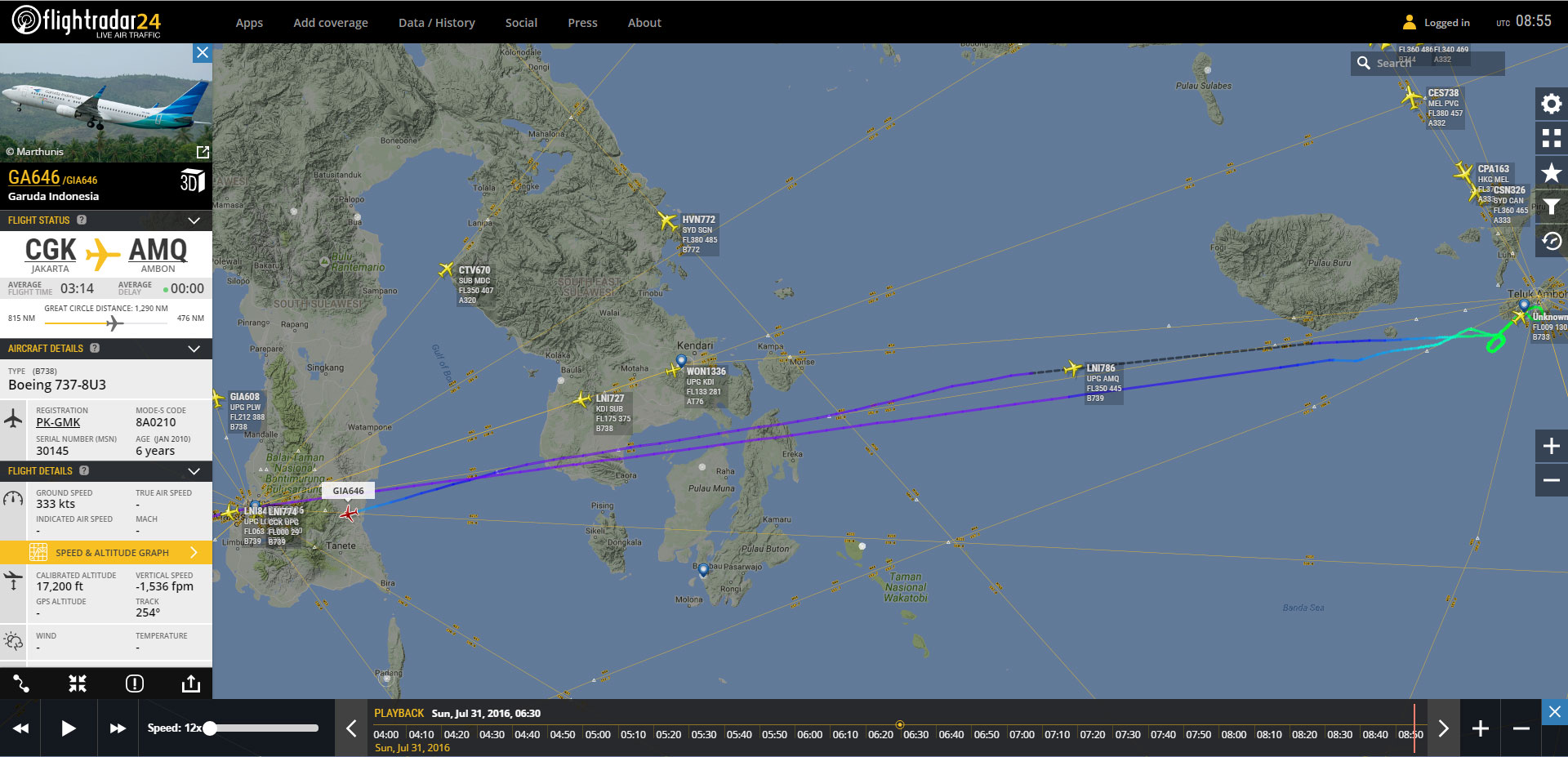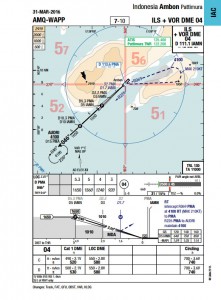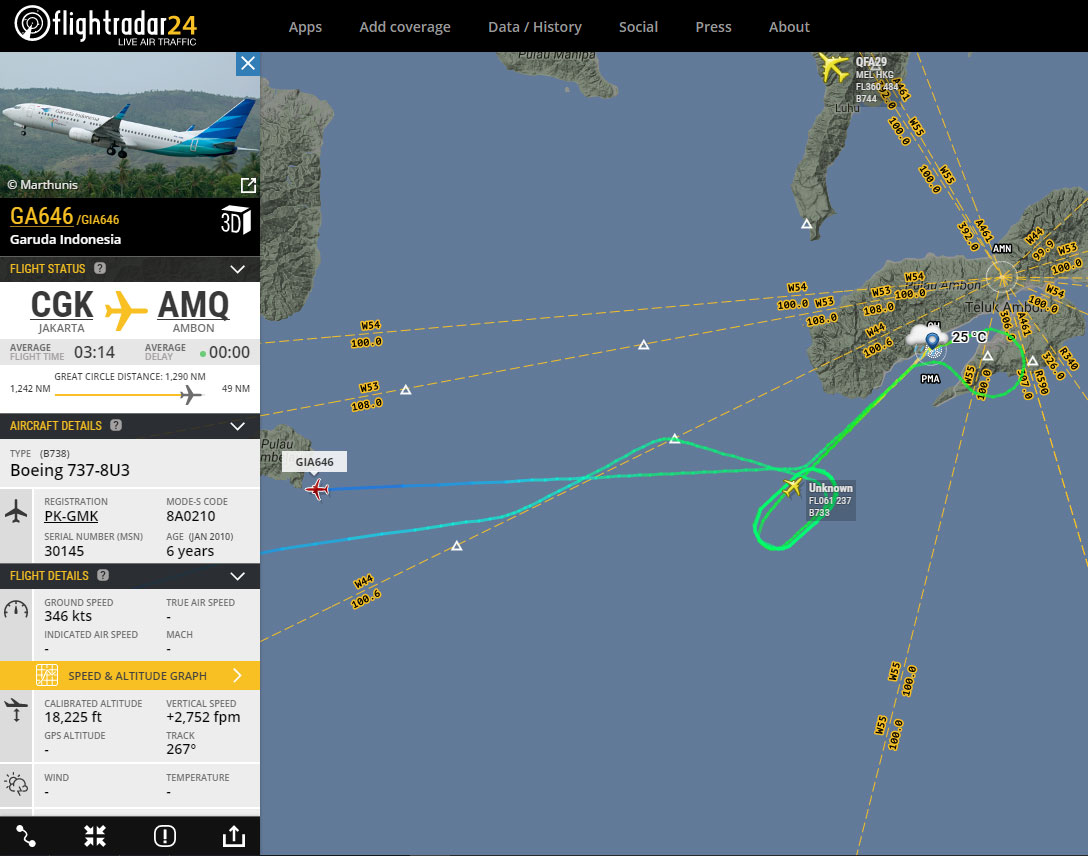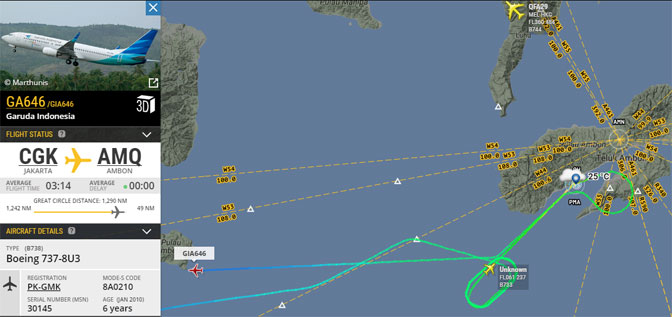At 0730UTC today I received a message, which had been spreading around various industry chat groups:
GIA646 WIII-WAPP at 05.22 req Divert to WAAA and at time 06.26 pilot state distress msg “Mayday 2x.” due to short fuel endurance just only 13 minutes” at position 56 miles east of Mks. A/c normal landing at 06.43 with high priority.
Being my usual curious self, I went to FlightRadar24 and searched for the aircraft. I soon found out the aircraft was operated by a 737-800 with registration PK-GMK, and that the aircraft had left relatively on time from Jakarta (CGK/WIII) towards Ambon (AMQ/WAPP), the aircraft made it to Ambon, then diverted to Makassar (UPG/WAAA).

A search at another site, revealed the following weather information:
- METAR: WAPP 310030Z 06003KT 020V080 2000 -RA FEW012CB BKN013 25/24 Q1011 TEMPO TL0100 5000 RMK CB TO E
- TAF: WAPP 310700Z 3107/0106 VRB06KT 1000 +RA FEW012CB BKN013 TEMPO 3112/3115 6000 NSW
Back to the replay. The following rough timeline was constructed by me based on the Flightradar24 replay (times in UTC, and there is a 7 minute or so time difference with the report above):
- 0400 GIA646 abeam of Kendari at FL350
- 0411 Batik Air A320 departed AMQ
- 0430 (approx) GIA646 commended descent
- 0443 Aircraft descended through 10000ft
- 0447 Aircraft at 6000ft about to enter holding at AUDRI at 6000ft.
- 0455 Batik Air 737-900ER departed AMQ, and 1 Wings Air ATR72 either before or after it.
- 0510 Aircraft left holding at AUDRI and passed 4000ft
- 0514 Aircraft at 400ft and commenced go-around.
- 0516 Aircraft reached 4000ft amidst missed-approach procedure, to return to AUDRI.
- 0525 Aircraft left holding fix at AUDRI to divert to Makassar (UPG/WAAA), 1 737-300 (unknown) was holding, and landed not long after. Aircraft did not hold after the missed-approach. Aircraft cruised at FL340 during the diversion and nothing out of the ordinary was observed.
- 0613 Top of Descent inbound UPG/WAAA
- 0634 Aircraft commenced approach
- 0636 Aircraft landed at UPG/WAAA
- 0709 A Lion Air 737-900ER landed at AMQ/WAPP

Before GIA646 arrived on scene, several aircraft had been holding due to weather at Ambon, but all had landed by the time it entered the area. From here it can be ascertained that apart from the bad weather and the go-around, nothing was unusual and it made little sense for the aircraft to declare Mayday due to low fuel upon descent to Makassar, unless a major screw up in the fuel planning occured, which was unlikely.

Let’s look back at what was reported:
GIA646 WIII-WAPP at 05.22 req Divert to WAAA and at time 06.26 pilot state distress msg “Mayday 2x.” due to short fuel endurance just only 13 minutes” at position 56 miles east of Mks. A/c normal landing at 06.43 with high priority.
If they only had 13 minutes of fuel left, why didn’t they declare the emergency before, after all, they declared it amidst their descent.
There is a possibility that there is a misunderstanding about the nature of the emergency and the requirement of fuel reserves. When planning your flight, under IFR rules in Indonesia, you must carry enough fuel to go from Origin to Destination, plus fuel to go from your Destination to you Alternate, and hold over your alternate for if I remember correctly, 30 minutes. You must also land with a final reserve of 30 minutes flight.
When do you declare your Mayday if you are low on fuel? The obvious answer is to declare a Mayday if you are sure your estimated fuel remaining after landing is going to be less than 30 minutes endurance.
Now while we don’t know the facts at the moment, we know that GIA646 did not have an excessive holding period near Ambon, and for it to claim to have only 13 minutes left of fuel while still on descent would constitute a massive screw up, I mean, MASSIVE! After the previous transport minister said “airlines should follow Garuda’s example”, and making rules requiring “face-to-face briefing between dispatchers and pilots,” if that aircraft did have only 13 minutes of fuel left, it just shows that those rules were just a burden with little or no use to generally accepted normal methodologies used in the world.
When the crew reported having only 13 minutes endurance at 0626, what was most likely was that they were going to land with less than 30 minutes of fuel on board, or, 43 minutes of fuel left. The aircraft landed at 0643, which was 17 minutes later, the Mayday call was justified.
A quick look at CASR Part 830.2 indicate that this is a serious incident as it involves:
830.2 b. 15) Fuel quantity requiring the declaration of an emergency by the pilot.
Now, this is where it gets interesting. Since the Air Asia 8501 accident, many had become concerned that the Directorate General of Civil Aviation were either by their own will, or by the instructions of the then Transport Minister (who seemed to have went on a rampage to blame LCCs and calling them as unsafe, and insisted that the industry should follow Garuda), as it put in several punitive regulations when it came to accidents and serious incidents. For this case, this would include:
- The suspension of routes, in this case the suspension of GIA646’s schedule until conclusion of the NTSC investigation.
- Barring the carrier, in this case, Garuda, from adding new routes and frequencies anywhere pending the investigation’s completion.
- Preventive grounding of the pilots involved, until the completion of the accident investigation.
Points 1 and 2 are, in the opinion of many in the industry (in Indonesia and the rest of the world), utterly useless, and may be aimed at sabotaging business recovery of airlines suffering these mishaps, likely under the premise of the then minister’s alleged favoritism of Garuda. Point 3, may appear normal but in Indonesia’s case at the moment, the grounding has always been extended to the whole investigation period (that is, until the publication of the final report, even if the interim report does not deem the crew actions to be a factor).
The challenge now for the DGCA and the current minister is to either:
- Prove impartiality by giving Garuda equal treatment to the other airlines that suffered serious incidents since these “silly rules” were put in place; or
- Remove these “silly rules” and restore common sense into our industry.
If the transport minister had not change, option 2 is out of the question, and option 1 would basically be slapping himself in the face. Regulatory partiality has been proven by one previous serious incident involving Citilink (Part of Garuda) that occurred since the “silly rules” were in force, escaping the punitive treatment by the DGCA, of which the saddest part of all is that some high ranking officials (well, I know at least one) there didn’t even know that it had happened.

I do hope that now, under the new minister, swift decision will be taken into putting alternative 1 in force while waiting for alternative 2 to take place. After all, the new minister had already announced he would make a wholesale review of rules that were counter-productive, which gives us in the industry a big ray of hope, and we do hope it includes these so-called “silly rules.”


We can adopt FAA InFO 08004 for declaration on Minimum Fuel & Emergency Fuel.
What is your company policy regarding this issue?